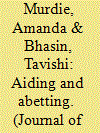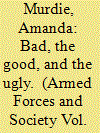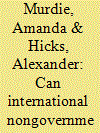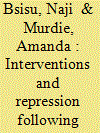|
|
|
Sort Order |
|
|
|
Items / Page
|
|
|
|
|
|
|
| Srl | Item |
| 1 |
ID:
104040


|
|
|
|
|
| Publication |
2011.
|
| Summary/Abstract |
This article studies the effects of human rights international nongovernmental organizations (INGOs) on domestic antigovernment protest. Unlike mainstream scholarship, the authors argue that human rights INGOs are not simply the magic bullet in orchestrating nonviolent protests; different types of human rights INGO activity have varying effects on protest. Moreover, some human rights INGO activities may lead to higher levels of violent protest. The empirical tests use new data on the activities of over 400 human rights INGOs and domestic nonviolent and violent protest globally from 1991 to 2004. The authors find that increases in human rights INGO activities reflecting a greater commitment to the domestic population are associated with higher levels of both violent and nonviolent protest.
|
|
|
|
|
|
|
|
|
|
|
|
|
|
|
|
| 2 |
ID:
119058


|
|
|
|
|
| Publication |
2013.
|
| Summary/Abstract |
Does civil-military conflict harm military effectiveness? Most previous empirical literature on the effects of civil-military conflict has utilized dichotomous indicators of the presence or absence of overall civilian control. However, the extant theoretical literature is clear that mid-levels of civil-military conflict could be good for innovation and overall decision making. In line with these arguments, the author argues that we should not expect all civil-military conflict to harm military effectiveness and, by extension, international crisis bargaining outcome. Instead, some civil-military conflict should have a positive effect on the overall success of the military. Utilizing new events data that captures the level of civil-military conflict cross nationally from 1990 to 2004, the author examines how civil-military conflict actually has an inverse U-shaped relationship with crisis success. This project also adds to the theoretical literature by examining variations across different degrees of civil-military conflicts, drawing attention to the usefulness of mid-range civil-military "friction."
|
|
|
|
|
|
|
|
|
|
|
|
|
|
|
|
| 3 |
ID:
123017


|
|
|
|
|
| Publication |
2013.
|
| Summary/Abstract |
Do international nongovernmental organizations (INGOs) lessen the need for states to provide their own services? In the case of health, many assume that INGOs limit health spending by governments. Against the conventional wisdom, we argue that these organizations create increased demand for governmental health spending through three mechanisms: (1) indirectly affecting the policy-making climate ("climatic conditioning"), (2) aiding domestic NGO and health activists in their efforts, and (3) directly pressuring governments for increased health spending themselves. Given these mechanisms, health INGOs, although typically supplying health services of their own within a country, should augment pressure for public service provision by the state and, it follows, lead to increased state health spending. We test our argument using a new data set on health INGOs, together with a well-established model of health spending, and find ample support for our arguments. Increases in health INGOs' activities do lead to increased governmental health spending, mainly by indirectly affecting the policy-making climate and, most especially, advancing the effective efforts of domestic activists.
|
|
|
|
|
|
|
|
|
|
|
|
|
|
|
|
| 4 |
ID:
138301


|
|
|
|
|
| Summary/Abstract |
What determines the location of those human rights international non-governmental organization (INGO) resources found outside of the highly developed Western democracies? We draw a distinction between the bottom-up mobilization processes driving the location of human rights organization (HRO) members from the top-down strategic concerns driving where HRO leaders place permanent offices. In particular, we find that, while political opportunity structures generally increase the likelihood that a state has HRO members, it has a curvilinear influence on the number of HRO secretariats, which typically locate in areas seen as having a higher need for organizational resources. Further, while there is no clear connection between human rights abuses and HRO memberships in a state, HROs' strategic concerns lead them to place offices with reference to both local and neighborhood “need”—in other words, levels of repression.
|
|
|
|
|
|
|
|
|
|
|
|
|
|
|
|
| 5 |
ID:
184201


|
|
|
|
|
| Summary/Abstract |
Civil conflicts inevitably have negative consequences with regards to respect for human rights within affected states. Unfortunately, the violation of human rights often does not end with the conflict. What factors explain variation in state repression in post-civil conflict societies? Can international interventions, both civilian and military, improve human rights in states with a history of conflict? Does the size of the intervention matter? We argue that international interventions, including peacekeeping missions and officially directed foreign aid, can reduce physical integrity abuses. This process occurs by simultaneously increasing protections for civilians while also raising the costs of repression to both government leaders and their agents. Human rights abuses will also decrease when there are legal remedies available to vulnerable populations which are bolstered by a strong judicial system. A robust civil society can also discourage human rights abuses by shedding light on these events and providing human rights education. In line with our theoretical argument, we focus on UN peacekeeping missions, especially those with human rights teams, and officially directed foreign aid for legal and security sector reform and NGOs. Using both a treatment effects approach and a continuous dose–response model, we find much support for the implications of our argument.
|
|
|
|
|
|
|
|
|
|
|
|
|
|
|
|
| 6 |
ID:
163442


|
|
|
|
|
| Summary/Abstract |
Which countries are likely to be ignored for their human rights abuses? This article focuses on one particular way that cases of human rights abuse might be overlooked by human rights organizations (HROs): the relative visibility of the state’s abusiveness vis-à-vis its geographic and social peers. HROs are more likely to target abusive states that are located in regions with more HRO resources and/or are surrounded by states that demonstrate higher respect for human rights, as these abuses will stand out much more clearly. Further, human rights treaties can be used by abusive states as a form of strategic “social camouflage,” with states trying to minimize the risk of HRO attention by ratifying human rights treaties to look more like their rights-respecting peers. Using a cross-national time-series research design, this article finds much support for the argument: abusive states that “join the chorus” avoid HRO attention.
|
|
|
|
|
|
|
|
|
|
|
|
|
|
|
|
| 7 |
ID:
191516


|
|
|
|
|
| Summary/Abstract |
What factors affect the likelihood that violent nonstate actors pursue and use chemical, biological, radiological, or nuclear (CBRN) weapons? What factors make a country at-risk for a CBRN terrorist attack? We argue that widespread repressive practices, also termed human rights abuses, are especially problematic in the fight to stop the pursuit or use of CBRN weapons. Repression by government forces severs ties between civilians and their government, leading those with knowledge of attacks to refrain from turning over necessary information. We test our argument quantitatively using data from the Big Allied and Dangerous Project and the Global Terrorism Database. Our results highlight how efforts taken to limit the use of repression may be an effective strategy to reduce risks of CBRN terrorism.
|
|
|
|
|
|
|
|
|
|
|
|
|
|
|
|
| 8 |
ID:
144873


|
|
|
|
|
| Summary/Abstract |
Why do Human Rights Organizations (HROs) target or “shame” countries for human rights abuses? The literature using country-level factors to explain why one country is likely to be targeted over another is growing but many questions still remain. Terrorist activity in a country should have a positive effect on the amount of shaming directed at a country. HROs are in the publicity business and have organizational interests to shame states already receiving attention. Findings show that there is a connection between certain types of transnational terrorist incidents occur in a country and the amount of HRO shaming of governments, even after accounting for the human rights practices within the state.
|
|
|
|
|
|
|
|
|
|
|
|
|
|
|
|
| 9 |
ID:
145700


|
|
|
|
|
| Summary/Abstract |
Networks of international nongovernmental organizations with missions concerning conflict resolution (CROs) conduct a number of innovative international programs designed to promote peace. Is this network of CROs effective? In this article, we argue that the CRO network can transmit information and promote norms of peace that help in reducing international conflict. Our theoretical argument builds on earlier work concerning international governmental organizations (IGOs) and peace and we examine whether and how the connections among states through CRO ties can lead to reductions in international conflict. We test the key empirical implication of our argument – concerning how the CRO network can foster peace – using new social network measures that focus on the actual network of citizens and elites connected internationally by CROs, rather than focusing on the size or presence of civil society within a state. We find considerable support for our central hypothesis that the network of international CROs is associated with peace. When a state is more embedded within the CRO network, international bellicosity from that state is diminished. This result holds at both the monadic and dyadic (non-directed and directed) levels of analysis. At the dyadic level, the CRO network works even when we account for the IGO network with a similar conflict resolution focus. At the dyadic level, we find that the greater the number of possible CRO informational channels between the states in the dyad, the less bellicosity within the dyad.
|
|
|
|
|
|
|
|
|
|
|
|
|
|
|
|
|
|
|
|
|